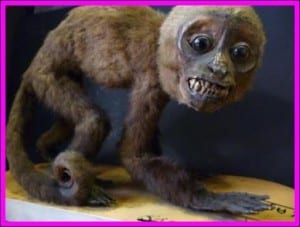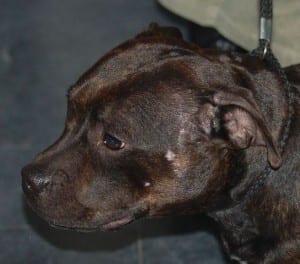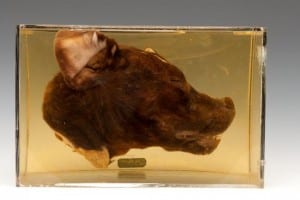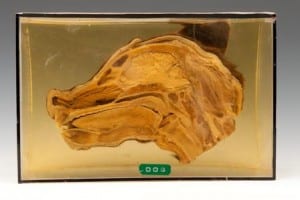Specimen of the Week: Week 163
By Will J Richard, on 24 November 2014
 Hello again! It’s me, Will Richard.
Hello again! It’s me, Will Richard.
Here for the second time doing my best to keep up the Grant’s grand traditions, but I’m afraid I must begin with an admission. I think I’ve made a mistake. Last month I made my blogging debut with a potto and it seemed like such a good idea at the time. Now, however, I’m faced with quite a problem. What can follow the potto?
Pacing the museum and racking my brains, peering into cases with increasing desperation, I am spoilt for choice so there’s no need to panic… let’s be logical. The potto is a teddy bear and where do you go when a teddy fails? A friend! Maybe even a best friend…
This week’s specimen of the week is:
**the Bisected dog head**
1) A dog’s life
The domestic dog (Canis lupus familiaris) was first domesticated from wild wolves, believed to have occurred in East Asia some 15,000 years ago. This would place the initial domestication prior to the development of settled agriculture. Since then humans have bred dogs in all shapes and sizes until they showed the greatest variety of any mammal species. There is nearly a hundred-fold difference in the weights of a Great Dane and a Chihuahua and yet, despite the obvious physical challenges, the two can breed.
2) Not just for Christmas
Normally an old dog would live up to 18 years. This specimen by comparison has been around for quite a bit longer. We know it was part of Sir Victor Negus’ collection which came to the Grant Museum via the Ferens Institute of Otolaryngology in 1991. While much of his original collection was destroyed in the war, he later rebuilt it. It is probable that this specimen was preserved during this period. A conservative estimate would, therefore, give a collection date of the mid 1950s.
3) What is that puppy in the window?
The kennel club currently recognises 210 breeds but all we have on our label here at the Museum is “dog”. I hope we can be a bit more precise.
The first thing of note is size. The head is relatively large, 22cm from nose to neck. We can exclude all toy and miniature breeds. The coat is short and appears soft (obviously I haven’t stroked it!) so we can eliminate the long-haired and coarse-haired varieties. The animal’s ear is short, measuring approximately 7cm tip to bottom. We are not looking at a spaniel. And although supported by the glass appears to be “half-pricked” (notice the fold half way up the ear from where in life it would have hung down). The snout is of medium length (5cm) and tapers back into a broad forehead (12cm across) and the eyes are set to look straight ahead. The specimen’s colouring is also of interest. It is not a pure black. Instead, I would describe it as more of a dappled brindle, with a splash of white on the forehead.
We are looking for a medium-sized breed that is short-haired, broad muzzled, with forward facing eyes, half-pricked ears and a brindle coat.
Hmmm….
By comparing the observations taken above with the Kennel Club standards I’ve come up with: The Staffordshire Bull Terrier. We are missing the entirety of the hind body and of course I can make no assessment of the animal’s temperament or gait but the colour, the coat type and the size and shape of the skull all fit.

Staffordshire Bull Terrier. Image by Lilly M CC-BY-SA-2.5 via Wikimedia Commons
4) If I’m right…
Originally bred for fighting the Staffordshire bull terrier (or staffie) was first recognised as a breed in 1935 as police clamped down on dog fights. Owners, wanting to justify large gatherings of staffies, sought breed recognition and subsequently held “dog shows”. The terrier is an off shoot of the bull baiting dogs that moved from the bull ring to the dog pit in the mid 1830s. The breed was, therefore, in existence for a hundred years prior to its recognition.
These troubled origins have followed them ever since. Summed up I think most eloquently in Phil Drabble’s entry in the remarkable “The Book of the Dog”, published in 1948 .
“Like most of the worthwhile things in life, a good Stafford is not attained without effort on the part of his owner. If he is thoroughly trained and well exercised, no dog could possibly be a more delightful companion. On the other hand, an untrained, under-exercised Stafford can do more mischief in a few moments than any dog I know.”
5) And if I’m wrong…
I am by no means the defining authority. Please do let me know what you think. It is possible, and in fact likely, that we are not looking at a pedigree specimen. In my assessment there is certainly some staffie in there. It fits morphologically and our estimated collection date falls after the recognition and radiation of the breed. But I’d better not change the specimen’s label just yet.
All we actually know is that it is, indisputably, “a dog”.
References:
The Behavioural Biology of Dogs; various authors edited by Per Jensen; CAB International; 2007.
The Book of the Dog; various authors edited by Brian Vesey-Fitzgerald; Nicholson & Watson; 1948.
Will Richard is Visitor Services Assistant at the Grant Museum of Zoology
4 Responses to “Specimen of the Week: Week 163”
- 1
-
2
Georgette Taylor wrote on 4 December 2014:
Oh, and another follow up, I’d say your dog is a bit more like my Rottweiller flavourede staffie than the other one. Particularly the slightly turned up nose (they get wrinkled muzzles when their noses get pushed back a bit either by eating or when they’re growling), and what looks like a thickly muscled head. The latter is very staffie. If your dog has any broken canines that would pretty much confirm it – their jaws are far too strong for their teeth.
-
3
James wrote on 8 April 2015:
As the owner of staffordshire bull terriers for over 10 years,
I would say that it’s a staffie. As you mentioned it looked like a staffie. -
4
Rock Room Slade School Takeover – Part 3 | UCL UCL Museums & Collections Blog wrote on 5 May 2015:

[…] casts and have helped organise the loan of an orang-utan’s arm, a chimp’s hand and a dog’s head in a jar from the Grant […]
 Close
Close




As the owner of staffordshire bull terriers (one at a time) for over 20 years now, I would agree entirely that it’s a staffie. In fact, before you mentioned it, I looked at it and thought how much it looked like my dogs. Although neither of them were kennel club specimens, but rescues (one from Staffie Rescue and one from Battersea Dogs Home). The first I think may have had a little Rottweiller floating around in his genes, and the second definitely has some border collie lurking in the background. But the majority is staffie, and I’d say so is yours. For what it’s worth.